steering Acura RL 2004 3.5 User Guide
[x] Cancel search | Manufacturer: ACURA, Model Year: 2004, Model line: RL, Model: Acura RL 2004Pages: 370, PDF Size: 4.33 MB
Page 22 of 370

If they do, they
could be very seriously injured in a
crash. Carrying hard or sharp
objects on your lap, or driving with
a pipe or other sharp objects in
your mouth, can result in injuries
if your f ront airbag inf lates.
If your
hands or arms are close to the
airbag cover in the center of the
steering wheel or on top of the
dashboard, they could be injured if
the front airbag inflates.
Devices intended to improve
occupant comf ort or reposition the
shoulder part of a seat belt can
severely compromise the
protective capability of the seat
belt and increase the chance of
serious injury in a crash. If a side airbag
inflates,acupholderorotherhard
object attached on or near the
door could be propelled inside the
vehicle and hurt someone.
Any object
attached to or placed on the covers
marked ‘‘SRS AIRBAG’’ in the
center of the steering wheel and
on top of the dashboard could
interf ere with the proper operation
of the airbags. Or, if the airbags
inf late, the objects could be
propelled inside the vehicle and
hurt someone.
Additional Saf ety Precautions
T wo people should never use t he
same seat belt . Do not place hard or sharp object s
bet ween yourself and a f rontairbag.
K eep your hands and arms awayf rom t he airbag covers.
Do not put any accessories on seat
belts. Do not at t ach hard object s on or
near a f ront door.
Do not at t ach or place object s on the f ront airbag covers.
Protecting Adults
Driver and Passenger Saf ety19
Page 50 of 370
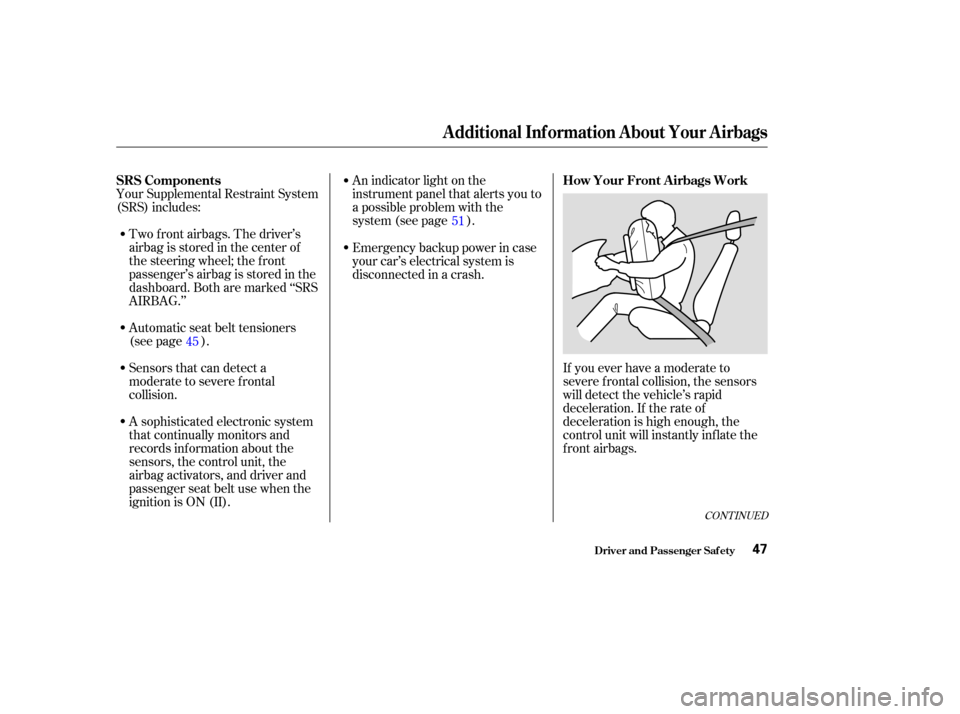
Your Supplemental Restraint System
(SRS) includes:An indicator light on the
instrument panel that alerts you to
a possible problem with the
system (see page ).
Two f ront airbags. The driver’s
airbag is stored in the center of
the steering wheel; the f ront
passenger’sairbagisstoredinthe
dashboard. Both are marked ‘‘SRS
AIRBAG.’’
Sensors that can detect a
moderate to severe frontal
collision. Automatic seat belt tensioners
(see page ). Emergency backup power in case
your car’s electrical system is
disconnected in a crash.
A sophisticated electronic system
that continually monitors and
records inf ormation about the
sensors, the control unit, the
airbag activators, and driver and
passenger seat belt use when the
ignition is ON (II). If you ever have a moderate to
severe f rontal collision, the sensors
will detect the vehicle’s rapid
deceleration. If the rate of
deceleration is high enough, the
control unit will instantly inf late the
f ront airbags.
51
45
CONT INUED
SRS Components How Your Front A irbags Work
Driver and Passenger Saf ety
Additional Inf ormation About Your Airbags
47
Page 58 of 370
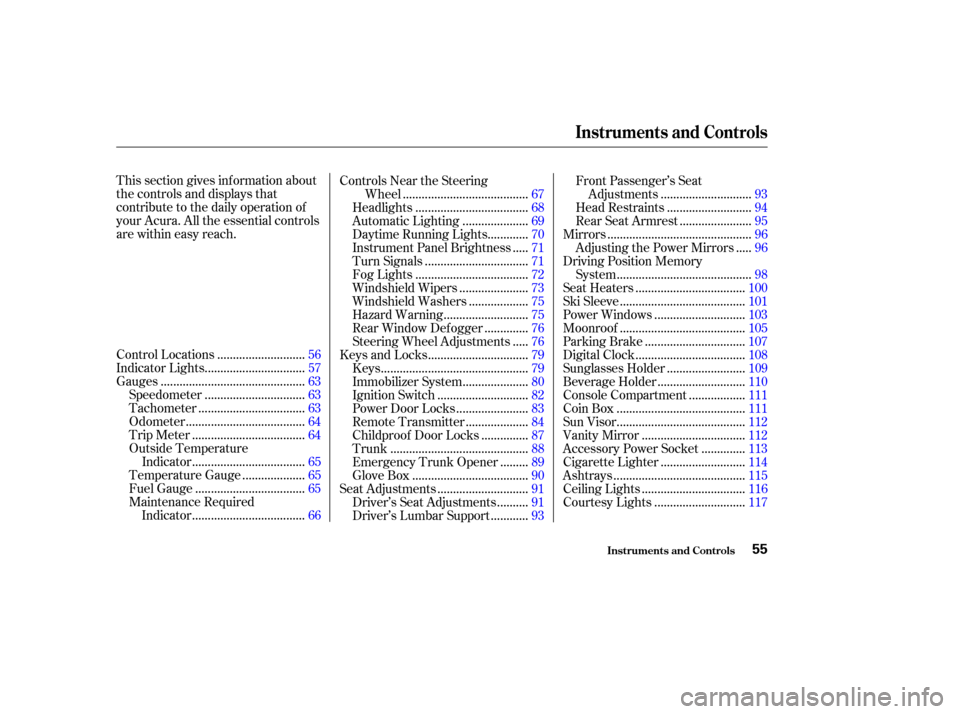
This section gives inf ormation about
the controls and displays that
contribute to the daily operation of
your Acura. All the essential controls
are within easy reach............................
Control Locations .56
...............................
Indicator Lights .57
.............................................
Gauges .63
...............................
Speedometer .63
.................................
Tachometer .63
.....................................
Odometer .64
...................................
Trip Meter .64
Outside Temperature ...................................
Indicator .65
...................
Temperature Gauge . 65
..................................
Fuel Gauge .65
Maintenance Required ...................................
Indicator .66 Controls Near the Steering
.......................................
Wheel .67
...................................
Headlights .68
....................
Automatic Lighting .69
............
Daytime Running Lights . 70
....
Instrument Panel Brightness . 71
................................
Turn Signals .71
...................................
Fog Lights .72
.....................
Windshield Wipers .73
..................
Windshield Washers . 75
..........................
Hazard Warning .75
.............
Rear Window Def ogger . 76
....
Steering Wheel Adjustments . 76
...............................
Keys and Locks .79
..............................................
Keys .79
....................
Immobilizer System . 80
............................
Ignition Switch .82
......................
Power Door Locks .83
...................
Remote Transmitter . 84
..............
Childproof Door Locks . 87
...........................................
Trunk .88
........
Emergency Trunk Opener . 89
....................................
Glove Box .90
............................
Seat Adjustments .91
.........
Driver’s Seat Adjustments . 91
...........
Driver’s Lumbar Support . 93Front Passenger’s Seat
............................
Adjustments .93
..........................
Head Restraints .94
......................
Rear Seat Armrest .95
.............................................
Mirrors .96
....
Adjusting the Power Mirrors . 96
Driving Position Memory ..........................................
System .98
..................................
Seat Heaters .100
.......................................
Ski Sleeve .101
............................
Power Windows .103
.......................................
Moonroof .105
...............................
Parking Brake .107
..................................
Digital Clock .108
........................
Sunglasses Holder .109
...........................
Beverage Holder .110
.................
Console Compartment . 111
........................................
Coin Box .111
........................................
Sun Visor .112
................................
Vanity Mirror .112
.............
Accessory Power Socket . 113
..........................
Cigarette Lighter .114
.........................................
Ashtrays .115
................................
Ceiling Lights .116
............................
Courtesy Lights .117
Instruments and Controls
Inst rument s and Cont rols55
Page 70 of 370
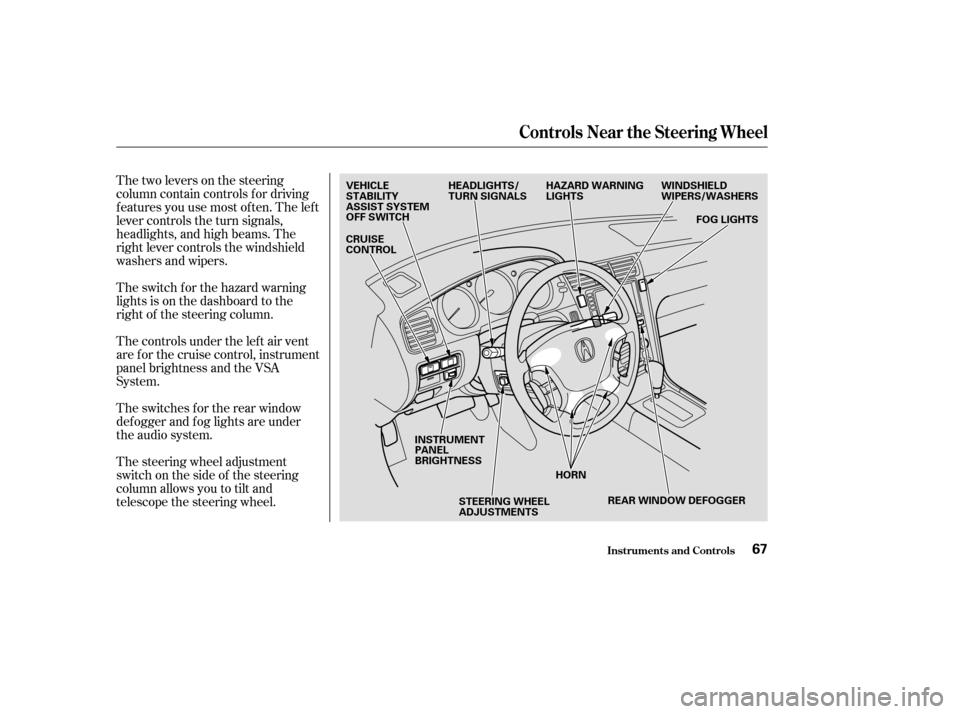
Thetwoleversonthesteering
column contain controls f or driving
f eatures you use most of ten. The lef t
lever controls the turn signals,
headlights, and high beams. The
right lever controls the windshield
washers and wipers.
The switch for the hazard warning
lights is on the dashboard to the
right of the steering column.
The controls under the lef t air vent
areforthecruisecontrol,instrument
panel brightness and the VSA
System.
The switches for the rear window
def ogger and f og lights are under
the audio system.
The steering wheel adjustment
switch on the side of the steering
column allows you to tilt and
telescope the steering wheel.
Controls Near the Steering Wheel
Inst rument s and Cont rols67
VEHICLE
STABILITY
ASSIST SYSTEM
OFF SWITCH
CRUISE
CONTROLSTEERING WHEEL
ADJUSTMENTS
HEADLIGHTS/
TURN SIGNALS
HAZARD WARNING
LIGHTS
INSTRUMENT
PANEL
BRIGHTNESS WINDSHIELD
WIPERS/WASHERS
HORN REAR WINDOW DEFOGGER FOG LIGHTS
Page 71 of 370
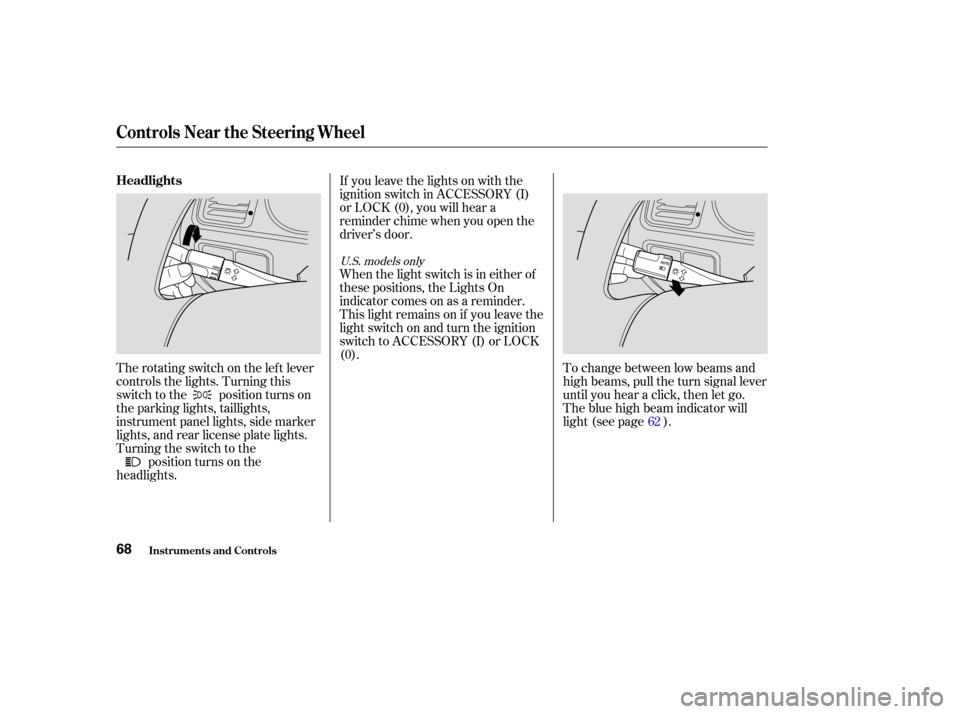
To change between low beams and
high beams, pull the turn signal lever
until you hear a click, then let go.
The blue high beam indicator will
light (see page ).
When the light switch is in either of
these positions, the Lights On
indicator comes on as a reminder.
This light remains on if you leave the
light switch on and turn the ignition
switch to ACCESSORY (I) or LOCK
(0). If you leave the lights on with the
ignition switch in ACCESSORY (I)
or LOCK (0), you will hear a
reminder chime when you open the
driver’s door.
The rotating switch on the lef t lever
controls the lights. Turning this
switch to the position turns on
the parking lights, taillights,
instrument panel lights, side marker
lights, and rear license plate lights.
Turning the switch to the position turns on the
headlights. 62
U.S. models only
Headlights
Controls Near the Steering Wheel
Inst rument s and Cont rols68
Page 72 of 370
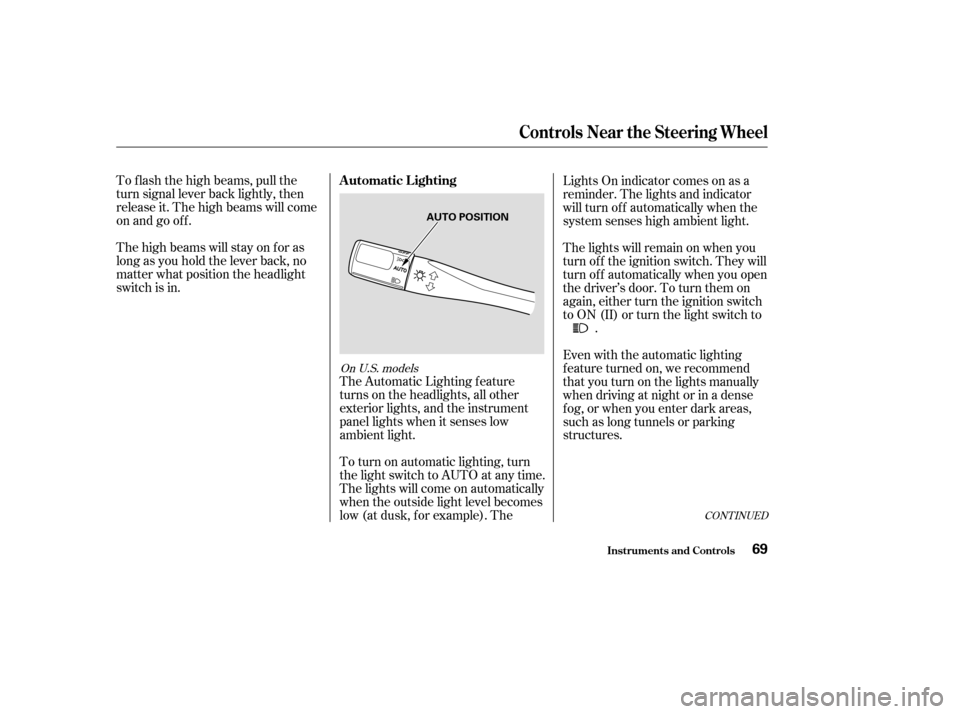
The high beams will stay on f or as
long as you hold the lever back, no
matter what position the headlight
switch is in. To f lash the high beams, pull the
turn signal lever back lightly, then
release it. The high beams will come
on and go off.The Automatic Lighting f eature
turns on the headlights, all other
exterior lights, and the instrument
panel lights when it senses low
ambient light.
To turn on automatic lighting, turn
the light switch to AUTO at any time.
The lights will come on automatically
when the outside light level becomes
low (at dusk, f or example). TheLights On indicator comes on as a
reminder. The lights and indicator
will turn of f automatically when the
system senses high ambient light.
The lights will remain on when you
turn of f the ignition switch. They will
turn of f automatically when you open
the driver’s door. To turn them on
again, either turn the ignition switch
to ON (II) or turn the light switch to
.
Even with the automatic lighting
f eature turned on, we recommend
thatyouturnonthelightsmanually
when driving at night or in a dense
f og, or when you enter dark areas,
such as long tunnels or parking
structures.
CONT INUED
On U.S. models
Automatic Lighting
Inst rument s and Cont rols
Controls Near the Steering Wheel
69
AUTO POSITION
Page 73 of 370
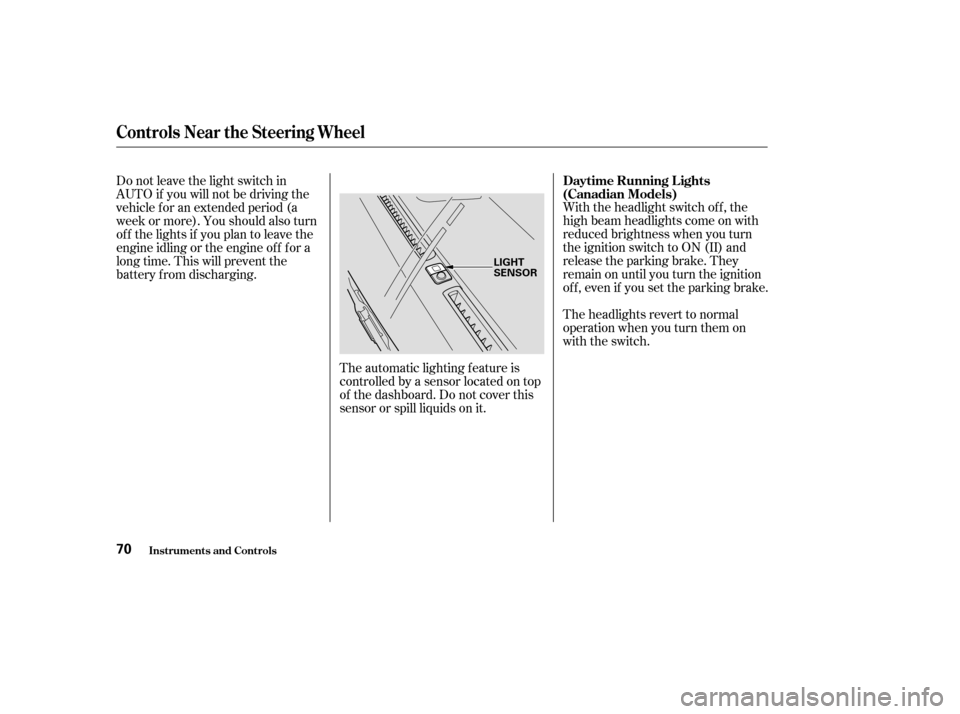
The automatic lighting f eature is
controlledbyasensorlocatedontop
of the dashboard. Do not cover this
sensor or spill liquids on it.With the headlight switch off, the
high beam headlights come on with
reduced brightness when you turn
the ignition switch to ON (II) and
release the parking brake. They
remain on until you turn the ignition
of f , even if you set the parking brake.
The headlights revert to normal
operation when you turn them on
with the switch.
Do not leave the light switch in
AUTO if you will not be driving the
vehicle f or an extended period (a
weekormore).Youshouldalsoturn
of f the lights if you plan to leave the
engine idling or the engine of f f or a
long time. This will prevent the
battery f rom discharging.
Daytime Running L ights
(Canadian Models)
Controls Near the Steering Wheel
Inst rument s and Cont rols70
LIGHT
SENSOR
Page 74 of 370
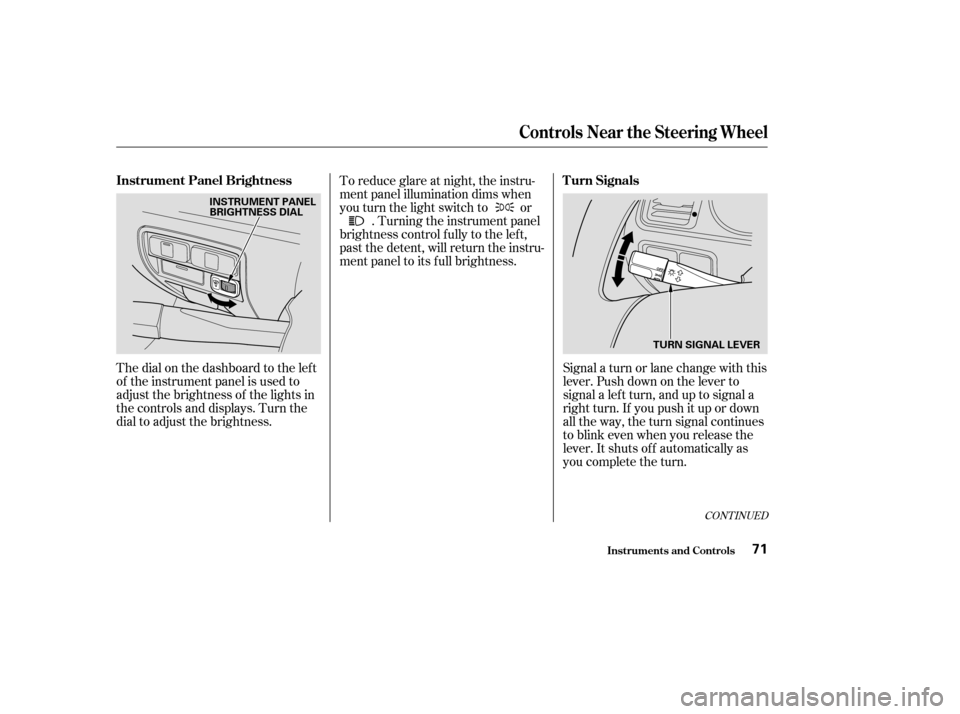
The dial on the dashboard to the lef t
of the instrument panel is used to
adjust the brightness of the lights in
the controls and displays. Turn the
dial to adjust the brightness.Signal a turn or lane change with this
lever. Push down on the lever to
signal a lef t turn, and up to signal a
right turn. If you push it up or down
all the way, the turn signal continues
to blink even when you release the
lever. It shuts off automatically as
you complete the turn.
To reduce glare at night, the instru-
ment panel illumination dims when
you turn the light switch to or
. Turning the instrument panel
brightness control f ully to the lef t,
past the detent, will return the instru-
ment panel to its f ull brightness.
CONT INUED
Instrument Panel Brightness T urn Signals
Inst rument s and Cont rols
Controls Near the Steering Wheel
71
TURN SIGNAL LEVER
INSTRUMENT PANEL
BRIGHTNESS DIAL
Page 75 of 370
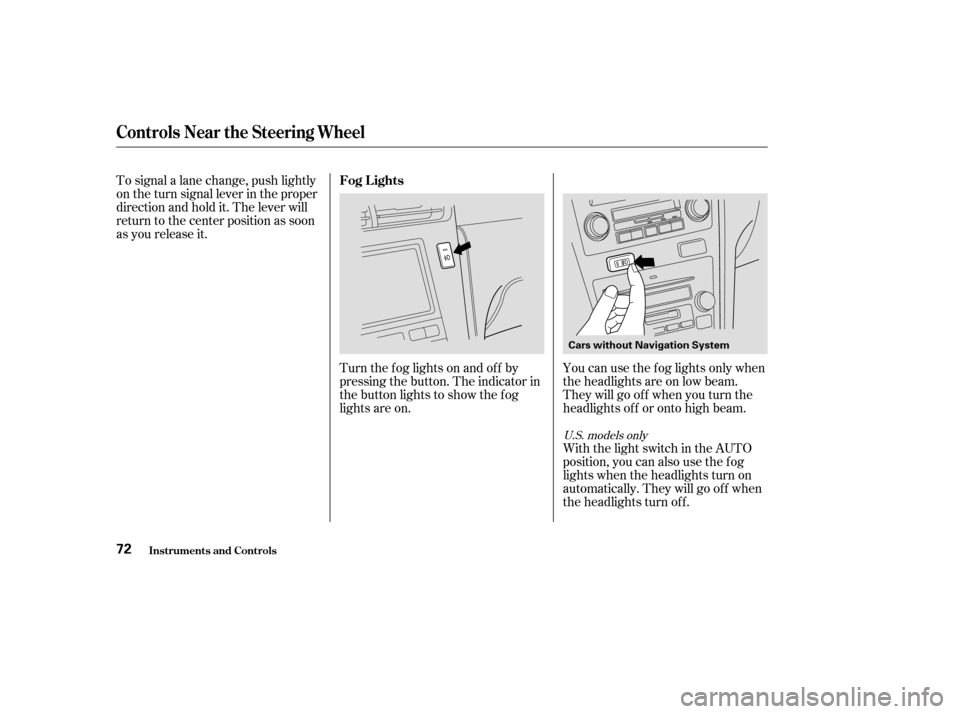
Turn the f og lights on and of f by
pressing the button. The indicator in
the button lights to show the f og
lights are on.
To signal a lane change, push lightly
on the turn signal lever in the proper
direction and hold it. The lever will
return to the center position as soon
as you release it.
You can use the f og lights only when
the headlights are on low beam.
They will go of f when you turn the
headlights of f or onto high beam.
With the light switch in the AUTO
position, you can also use the f og
lights when the headlights turn on
automatically. They will go of f when
the headlights turn of f .
U.S. models only
Fog Lights
Controls Near the Steering Wheel
Inst rument s and Cont rols72
Cars without Navigation System
Page 76 of 370
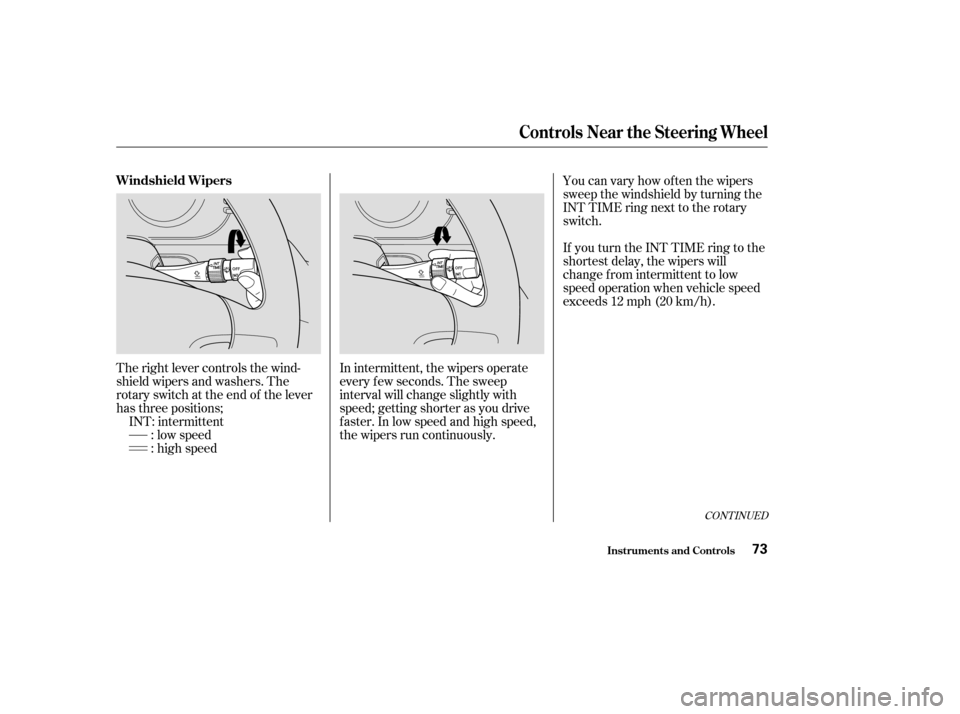
The right lever controls the wind-
shield wipers and washers. The
rotary switch at the end of the lever
has three positions;INT: intermittent : low speed
: high speed In intermittent, the wipers operate
every f ew seconds. The sweep
interval will change slightly with
speed; getting shorter as you drive
f aster. In low speed and high speed,
the wipers run continuously. You can vary how of ten the wipers
sweep the windshield by turning the
INT TIME ring next to the rotary
switch.
If you turn the INT TIME ring to the
shortest delay, the wipers will
change from intermittent to low
speed operation when vehicle speed
exceeds 12 mph (20 km/h).
CONT INUED
Windshield Wipers
Inst rument s and Cont rols
Controls Near the Steering Wheel
73